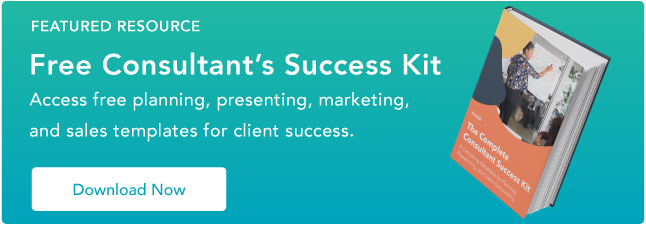It might sound like a no-brainer, but it's still worth noting: customers don't want to be sold to, they want to be understood. It's why pushy pitches and cheap gimmicks fall short with many consumers.
But if you're a salesperson looking to connect with your customers and build long-lasting relationships, consultative selling could be the right approach.

Let's explore the concept further, review its core principles, walk through the selling process, and see an example of it in practice.
Table of Contents
Consultative Selling Principles
Consultative Selling vs. Solution Selling
The Consultative Selling Process
The Consultative Selling Example
What is consultative selling?
Consultative selling is an approach that focuses on creating value and trust with a prospect and exploring their needs before offering a solution. The salesperson’s first objective is building a relationship; their second is providing the right product.
Picture this: You walk into a store looking to buy a new pair of shoes. As soon as you step in, a salesperson approaches you and starts pitching the latest shoe collection without even asking what you are looking for. Overwhelmed and frustrated, you leave the store without making a purchase.
Now, imagine the opposite. You walk into a store, and a salesperson greets you warmly and asks about your preferences, what type of shoes you need, and if you have any specific requirements. They listen to you carefully, and then provide a few options that meet your criteria. As you walk to the cash register, you feel confident that you're making the right purchase.
This is the power of consultative selling.
.png)
8 Free Consulting Templates
Access 8 templates for consultants in The Complete Consultant's Success Kit.
- Management Consulting Plan Template
- Business Plan Template
- Sales Plan Template
- And More!
Download Free
All fields are required.
.png)
Instead of simply pitching a product or service, consultative selling seeks to understand the prospect's situation, goals, and challenges in order to provide a tailored solution that meets their needs.
One of the key benefits of consultative selling is that it helps build trust and credibility with the prospect. By taking the time to understand their unique needs and providing thoughtful solutions, the prospect is more likely to view the salesperson as a trusted advisor rather than just another pushy salesperson.
Putting this strategy into action requires seven key principles:
Consultative Selling Principles
- Balance questions with insights.
- Build knowledge-based trust.
- Keep it conversational and genuine.
- Take ownership of the conversation.
- Let feedback guide the process.
- Research customer needs and offer relevant findings.
- Listen intently.
1. Balance questions with insights.
There's no way around it: the path to the sale starts by understanding your customer’s needs. Developing this detailed picture is beneficial to you, the seller, because it’s beneficial to your prospect. But all too often, sellers position solutions that aren’t a fit for the customer.
Sellers need to ask questions. However, that process takes time, and asking too many can make a customer feel like they’re being interrogated. The solution? Offer insights along the way.
For instance, say you’re selling an all-in-one CRM software to a prospect primarily interested in sales automation, but the conversation shifts to customer service.
If that were to happen, berating your buyer with questions about their support infrastructure wouldn't be the right approach. Instead, you would want to briefly discuss how well your solution has suited businesses similar to your customer's before moving on.
This earns you the right to ask questions. Insights provide rationale for your questions and build credibility.
2. Build knowledge-based trust.
While it’s true that more customers today are willing to engage sellers remotely, it’s also true that earning that trust is more of a challenge. Sellers can overcome this obstacle by developing knowledge-based trust: the process of building trust from actions that are consistent with words.
Sellers should try to deliver on at least one follow-up after the call. You could call your buyer, let them know it was a pleasure to speak with them, reference specific topics that came up in your conversation, and remind them to reach out if they have any questions.
The subject of the follow-up isn’t necessarily its point. It's the opportunity to show your customers exactly how reliable and thoughtful you are. It shows you’re a person of your word.
This legitimizes your solution’s value and helps build a solid, trustworthy relationship between you and a potential customer.
3. Keep it conversational and genuine.
The process of building trust with a customer goes beyond establishing rapport with knowledge. You also need to be disarming, appear approachable, and show you genuinely care about both what you’re selling and who you’re selling it to.
That means speaking with real enthusiasm and meaning what you say. In other words, do what you can to keep your prospect engaged without coming off like a stereotypical, sleazy used car salesperson who puts on a fake smile every time someone comes onto their lot.
That’s not the energy you want to bring to your consultative sales approach. You have to be more real than that. Believe in your product and discuss it with genuine conviction and honesty.
Understand your product’s value and speak to that. You should also try to identify something personally meaningful to your prospect and spend some time talking about that as well.
In short, be casually compelling, open with your intentions, and authentic with your pitch.
4. Take ownership of the conversation.
Dialogue is the key to the consultative style. However, sellers still need to guide the conversation. The customer needs to understand they’re partnering with someone who can guide them through the complexities of business challenges.
Sellers should be prepared to reference examples of relevant work in the customer’s area with concise messaging — assertiveness underscores capability.
Taking ownership demonstrates credibility. The seller’s control of the conversation is a way to shape perceptions. But control doesn’t mean dominance; sellers must also be comfortable with using silence to emphasize key points and let their customers have a turn.
For instance, it can be helpful to be silent after making an offer. This can apply some pressure on prospects while they get a feel for what’s on the table. A lot of people will negotiate on their own to fill the quiet and can even end up talking themselves into very seller-friendly deals.
5. Let feedback guide the process.
There’s no such thing as bad feedback. Even the strongest customer objections offer an invaluable benefit to the seller. When a customer articulates a concern or disagreement, they’re clarifying their needs and indicating what they want to see moving forward.
Therefore, it’s important for the seller to carefully consider every piece of feedback. Be sure to take notes. And don’t be afraid to check with the customer that the solutions discussed meet their challenges.
Asking for the customer’s perspective demonstrates the seller’s commitment to a collaborative, consultative sales process. In some cases, gaining feedback will even offer an opportunity to expand the solution.
If you were selling software solutions for small businesses and a prospect said they were concerned about whether your solution fits a company the size of theirs, you would want to take that to heart. That would help you identify a vulnerable point in your sales pitch that you can pay more attention to as the process goes on.
.png)
8 Free Consulting Templates
Access 8 templates for consultants in The Complete Consultant's Success Kit.
- Management Consulting Plan Template
- Business Plan Template
- Sales Plan Template
- And More!
Download Free
All fields are required.
.png)
6. Research customer needs and offer relevant findings.
Sellers need to research the businesses and industries they're approaching in advance. Doing so equips the seller with the requisite base knowledge, allowing them to start with the most incisive questions first.
By researching potential gaps and needs in advance, sellers can identify opportunities to create differentiated value.
For instance, if you’re selling cybersecurity solutions, you should be familiar with the security regulations specific to your prospect’s industry. From there, you can identify the edge your product may have in helping customers achieve compliance with those standards.
Once these differentiators are understood, sellers can map their capabilities to customer needs. Ultimately, customers will be receptive to what those salespeople have to say because their information is relatable.
The key is to limit your ideas to the most relevant, cogent ones. The urge to demonstrate the value of one’s research is often strong, but you need to push back on it. Create a bigger impact with just a few concise insights.
With a hypothetical all-in-one CRM pitch, you wouldn’t want to mull over every last feature of the sales and marketing aspects of the platform if you know your prospect is looking for a solution to improve its customer support infrastructure. Lock down the points you need to make and trim the fat from your consultive approach.
7. Listen intently.
Consultative selling is customer-centric, meaning priority number one has to be hearing what your prospects have to say. Give them some room to talk. As previously mentioned, you should take ownership of the conversation, but there’s a difference between ownership and dominance.
Avoid obnoxious tactics that can come off as competitive or combative. Don’t interrupt their train of thought with your own solutions to their problems. Also, be mindful of other factors that may speak to how well the conversation is going, including any nonverbal cues they may be conveying, like uncomfortable body language or facial expressions.
The key here is to sympathize with your prospects. Let them know that their issues matter to you and that you have a vested interest in solving them.
Consultative Selling vs. Solution Selling
Solution selling — a brand of sales where a salesperson pitches a product or service based on solutions instead of features — is often conflated with consultative selling. And that kind of confusion is fair.
In some cases, the terms are even used interchangeably. Both brands of sales are rooted in empathy and taking time to fundamentally understand a prospect's mindset and situation.

However, you can see a key difference in the value propositions of each respective approach. Consultative sellers use value propositions that have a slightly more product-oriented edge to them — whereas solution seller's use solution-driven value propositions.
Additionally, consultative selling is more associated with the relationship-building element of sales. When people use the term, they're generally touching on that aspect of the methodology. Solution selling, on the other hand, is typically linked to the idea of selling a product or service with a solution as the main focal point.
Again, the two terms are extremely similar and can bleed into each other in many respects. Consultative selling tactics have a place in solution selling, and solving for the customer is a fundamental tenet of effective consultative sales.
The Consultative Selling Process
1. Research.
Any solid consultative selling effort starts with thorough research. You can't go into a sale totally blind, banking on your ability to figure out who your prospect is on the fly. You need to have a solid, baseline understanding of who you're selling to.
That includes information related to their industry, their competition, the solutions they're currently leveraging, who has decision-making authority at the company, and any other relevant points that would sway their decision to buy a product or service like yours.
Scour LinkedIn. Pore through their website. Read up on industry-specific educational content. If you have customers that fit a similar bill, go through any information you have on how they leveraged your solution and what kind of success they saw.
One way or another, set yourself up for success by educating yourself as best you can.
2. Ask questions and listen actively.
Once you're in a position where you can directly engage with the prospect, ask thoughtful, open-ended questions that can help you tease out pain points. Most of those questions should have some degree of specificity and personalization — it's an opportunity for you to apply your research.
And be sure to listen actively and intently when your prospect answers those questions. Demonstrate that you hear them by remaining engaged, paraphrasing their answers, and reflecting what they say.
In doing so, you'll gain the insight you need to inform better-targeted solutions and communication through the remainder of the consultative selling process, position yourself as a trustworthy advisor, and start to build a productive relationship with your prospect.
.png)
8 Free Consulting Templates
Access 8 templates for consultants in The Complete Consultant's Success Kit.
- Management Consulting Plan Template
- Business Plan Template
- Sales Plan Template
- And More!
Download Free
All fields are required.
.png)
3. Diagnose your prospect's issues, and determine solutions.
Once you've asked a thoughtful line of questions, actively listened to your prospect's answers, and begun to develop your relationship with them, it's time to figure out how you — specifically — can help them.
Figure out what your prospect's main issues, concerns, and priorities were. What came up most consistently? What did they seem to stress more than anything else? If they were to use your product or service, what would they be using it for? What outcomes did they want to see?
This information will ultimately shape your value proposition. Consultative selling value propositions are unique in that they are both solution and product-oriented. Your first priority is to sell your prospect on the outcomes they'll see — to show that you both understand their most pressing problems and know how your solution will remedy them.
Then, you want to be a bit more pointed in terms of which aspects of your product or service will bring those outcomes to fruition. Both elements need to have a personal edge to them. Successful consultative selling is customer-specific — and your value proposition needs to reflect that.
4. Educate your prospect on the solutions you come up with.
You have your intel and a solid idea of what you can do for your prospect — now, you need to relay that information to them confidently and effectively. Consultative selling pitches, presentations, and conversations need to show a high degree of personalized understanding.
You built a relationship. Now, prove you take it seriously.
You need to show that you listened. Convey a value proposition that will help their business — you don't want to offer some vague spiel about how businesses in general fare with your product or rattle off a list of all its features.
Don't be pushy. Don't be arrogant. Don't be aggressive. And be prepared to field more questions and potential objections. You need to be thoroughly prepared and open-minded, and always remember that this isn't about you — it's about them.

Consultative Selling Example
For the sake of example, let's imagine a B2B SaaS company that sells construction project management software, and go over how a salesperson from that company might take a consultative approach with a construction contractor currently building franchises for a regional fast-food chain.
1. Step 1: Research.
Before the salesperson can legitimately engage in consultative selling, they need to know what they're getting into. They'd thoroughly research the firm in question to know for sure that it's a good fit for the product.
They'd see what projects the contractor had taken on up to this point. If possible, they would get insight into the solutions it's currently leveraging — in doing so, they might identify gaps in their project management stack, find out whether they're using a competitor's product, or find out that they're flat-out not using any construction management software at all.
They'd also look into the project the contractor is currently working on to see if the type of building the firm is doing could benefit from the kind of software the salesperson is selling. They might also familiarize themselves with company leadership to ensure they're speaking to the right people.
Ultimately, they'd take the necessary strides to approach their conversations with a prospect from an educated, well-prepared vantage point. Consultative selling is about understanding who you're talking to — that process starts well before the conversation does.
2. Step 2: Ask questions and listen actively.
After connecting with one of the company's decision-makers and conducting research, the salesperson would continue the consultative sales process by asking thoughtful, targeted questions to expose the prospect's pain points and even make them consider issues they hadn't thought about.
They might ask questions like:
"You've constructed two franchises in the past year and a half. Are you working at the pace you'd like to be?"
"Have hitches in communication between you and other stakeholders have any impact on your progress?"
"How much of a priority is being able to help manage construction remotely for you?"
"Has quality control been an issue for you?"
Through this stage, the salesperson would listen actively and intently — considering what the prospect has to say and asking more questions based on the information they offer. In doing so, the salesperson can better set the stage for a thoughtfully tailored, effective value proposition.
3. Step 3: Diagnose your prospect's issues, and determine solutions.
Once our rep has had their conversation with the fast-food chain's decision-maker, they can start to piece together a thoughtful solution. Let's say the prospect's answers were indicative of the issues with project visibility — they're struggling to keep their projects organized and prolonging construction as a result.
In that case, our salesperson would take a deep dive into their own product and look at the features that could suit that issue. Let's say the software has features that allow for comprehensive project overviews and the ability for stakeholders to submit tickets with outstanding issues.
Here, the salesperson would piece together a value proposition that would provide hard figures and meaningful solutions related to how much more efficient their software could make the prospect's operations — along with some specific insight on how that would work. If project visibility was a major concern, they'd likely specifically cite the feature I mentioned.
4. Step 4: Educate your prospect on the solutions you come up with.
Now that our rep has made inroads with the contractor and has a solid grasp on the firm's needs, interests, and circumstances, it's time for them to present their solutions and hopefully land the deal.
The salesperson would outline their understanding of how the prospect's current project management organization is tripping up their progress. Ideally, they'd have some resources to show the prospect about how similar firms have seen improvements in this area as a result of leveraging the salesperson's product or service.
The salesperson would confidently identify the "what" behind the problem and demonstrate that their product can be the "how" behind its solution. They'd field any objections the contractor might have and take them seriously.
If they've been actively involved from a consultative perspective, they'd probably be able to anticipate the issues the contractor might raise.
The sales landscape is changing, and being able to develop and sustain interpersonal relationships is becoming more and more essential. The consultative approach may be the best way to keep pace with that shift.
The approach also helps sellers apply a consistent methodology to an ever-changing audience and ultimately drive more sales.
Editor's note: This post was originally published in December 2019 and has been updated for comprehensiveness.
.png?width=112&height=112&name=Image%20Hackathon%20%E2%80%93%20Vertical%20(92).png)



![How to Write a Consulting Proposal [Templates & Examples]](https://knowledge.hubspot.com/hubfs/ft-consulting.webp)

![Start a Consulting Business in 6 Steps [+Ideas for Your Venture]](https://www.hubspot.com/hubfs/image1-Apr-06-2023-09-15-56-0028-PM.png)





![15+ Interview Questions for Consultants [+ Sample Responses]](https://53.fs1.hubspotusercontent-na1.net/hubfs/53/Consultant%20Interview.png)